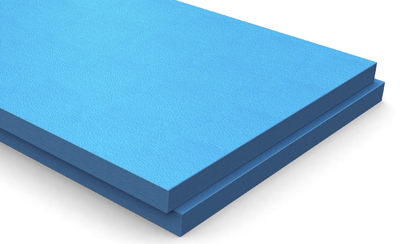General information
The high-strength extruded thermal insulation products made of polystyrene can be used advantageously for the thermal insulation of floor structures laid on the soil. Regardless of the function and construction of the building, they can be inserted beneath or above the floor plate.
The thermal insulation placed beneath the floor plate is continuously exposed to intensive stresses and load caused by:
daily use (movement of vehicles, forklift trucks, weight of high shelved racks, machines, industrial equipment)
static load (load transferred form adjacent building structures)
dynamic load (starting, breaking, vibration)
mechanical load generated during the implementation phase.
Irrespective of the type of load, the best option for the thermal insulation of industrial floors can be chosen from among the RAVATHERM™ XPS 300 SL, RAVATHERM™ XPS 500 SL or RAVATHERM™ XPS 700 SL products. Each of the three options guarantees excellent thermal insulation, high compressive strength and stability during the foreseeable life of the building.
Other information
The RAVATHERM™ XPS extruded polystyrene foam plates are suitable for ensuring thermal insulation of floors laid on the soil, in case of:
- floor plates placed between strip foundation and pier foundation
- industrial floor exposed to excessive load (shelved racks in warehouses, forklift trucks, cargo vehicles)
- airport hangars
when they are laid directly onto compacted gravel or sand bed or on a blinding layer of concrete.
The manufacturing procedure of extruded polystyrene (XPS) plates produces a homogen-eous, closed-cell material structure having smooth surface skin (the so-called extrusion crust) which features various favorable characteristics, like:
- permanently high insulation co-efficient,
- water and frost resistance,
- high strength,
- high elastic rigidity,
- high resistance to damp diffusion
Such favourable properties make the XPS thermal insulation material suitable, beyond other applications, for the perfect implementation of industrial floors.
FAVORABLE ORDER OF LAYERS IN FLOORS
Owing to their positioning below the floor plates, the thermal insulation plates constitute integral components of the load bearing structure. Due to their high strength, permanently high thermal insulation coefficient and resistance to moisture and frost, the use of the RAVATHERM™ XPS products enables construction of simple floor structure of small layer thickness.
PERMANENT LOAD COEFFICIENT
In case of heat insulating cellular foams, such short time (nominal) compressive strength values should not be used for supporting structural calculations, however, they can be used for making strength comparisons and classification. For the purpose of determining the capacity of the floor structure (which contains also the thermal insulation layer) to withstand permanent and useful loads, the value of compressive strength related to the permanent load must be used.
Technical
STATIC DIMENSIONING
As to determine the load bearing capacity, under permanent and useful loads, of the floor structure which contains also the thermal insulation layer, the value of compressive strength related to the permanent load must be used (compressive stress, assuming 2% compression, during 50 years).
The volume of steel reinforcement to be integrated in the floor plate (considered a load distribution structure) should be calculated in corporation with a supporting structure designer.
DILATATION
The integration of dilatation inserts is an important aspect also in case of industrial floors, particularly those built in places exposed to varying temperatures.
INSTALLATION
The RAVATHERM XPS thermal insulation products should be laid in an offset binding, directly on the compacted gravel bed or a thin blinding layer of concrete, complete with sand leveling, if necessary.
The plates can be cut to size with heat cutter, knife or small-tooth saw. The cut surfaces can be fitted together precisely.
Owing to the high strength, the distance pieces of the plate reinforcement do not indent into the thermal insulation plates, - this way ensuring the necessary concrete cover.
PROTECTION OF INSULATION
When the thermal insulation plates are laid on top of the insulation provided against soil humidity and groundwater, they provide also mechanical protection during the construction phase. This role is particularly important during the installation of the steel reinforcement in concrete.

